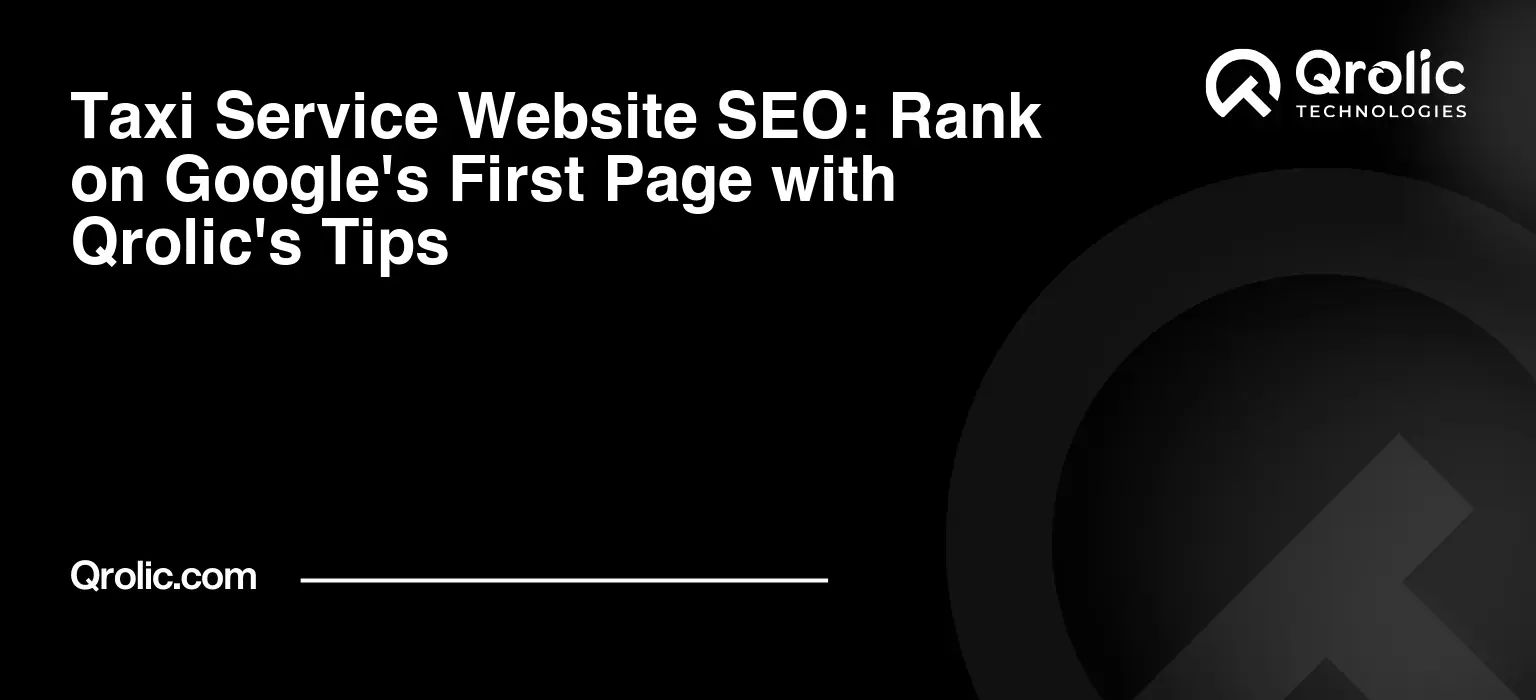Quick Summary:
- A robust website is crucial for taxi business growth.
- Essential features include online booking and clear service details.
- Optimize your site for mobile, visuals, and search engines.
Table of Contents
- The Indispensable Foundation: Why Your Taxi Service Needs a Stellar Website
- Why a Website is Non-Negotiable
- Core Functionality: The Must-Have Features for a Taxi Website
- 1. Online Booking System: The Heart of Your Taxi Website
- Essential Elements of an Online Booking System
- Benefits of an Effective Online Booking System
- 2. Service Information: Transparency and Clarity
- Essential Information to Include
- 3. About Us: Building Trust and Credibility
- Key Elements of an Effective “About Us” Page
- 4. Contact Information: Making it Easy to Reach You
- Essential Contact Information
- 5. FAQ Section: Addressing Common Questions
- Common Questions to Address
- Enhanced User Experience: Taking Your Website to the Next Level
- 1. Mobile Responsiveness: Catering to On-the-Go Users
- Why Mobile Responsiveness Matters
- 2. Clear Call-to-Actions (CTAs): Guiding Users to Conversion
- Examples of Effective CTAs
- 3. High-Quality Images and Videos: Visual Appeal and Engagement
- Types of Visual Content to Include
- 4. Blog: Providing Valuable Content and Boosting SEO
- Blog Content Ideas
- 5. Customer Reviews and Testimonials: Building Social Proof
- Ways to Showcase Customer Reviews
- Advanced Features: Gaining a Competitive Advantage
- 1. Real-Time Tracking: Providing Peace of Mind
- Benefits of Real-Time Tracking
- 2. Loyalty Programs: Rewarding Repeat Customers
- Types of Loyalty Programs
- 3. Integration with Third-Party Apps: Expanding Your Reach
- Benefits of Third-Party Integration
- 4. Multilingual Support: Catering to a Diverse Customer Base
- Languages to Consider
- 5. Accessibility Features: Ensuring Inclusivity
- Accessibility Guidelines
- Optimizing for Search Engines (SEO): Driving Organic Traffic
- 1. Keyword Research: Identifying Relevant Keywords
- Keyword Examples
- 2. On-Page Optimization: Optimizing Your Website Content
- On-Page Optimization Techniques
- 3. Off-Page Optimization: Building Authority and Backlinks
- Off-Page Optimization Techniques
- 4. Local SEO: Targeting Local Customers
- Local SEO Techniques
- 5. Monitor and Analyze Your Results: Tracking Your Progress
- Key Metrics to Track
- Qrolic Technologies: Your Partner in Building a Winning Taxi Website
- Conclusion: The Road to Success Starts Online
The Indispensable Foundation: Why Your Taxi Service Needs a Stellar Website

In today’s digital landscape, a taxi service without a robust online presence is like a cab without wheels – it’s simply not going anywhere. Your website is the digital storefront, the first impression, and often the deciding factor for potential customers choosing your service over the competition. A well-designed website isn’t just a nice-to-have; it’s an essential tool for growth, customer acquisition, and long-term success.
Why a Website is Non-Negotiable
-
24/7 Availability: Unlike a physical taxi stand or phone line, your website is always open for business. Customers can book rides, get quotes, and find information at any time, day or night. This convenience is a major advantage in today’s on-demand world.
-
Brand Building and Trust: A professional website builds trust and credibility. It tells potential customers that you are a legitimate, reliable business that takes its service seriously. Think of it as the digital equivalent of a clean, well-maintained taxi cab.
-
Competitive Edge: In a crowded market, a strong online presence can set you apart. A well-designed website with user-friendly features can attract customers who might otherwise choose a competitor with a less appealing online experience.
-
Marketing Powerhouse: Your website is a central hub for all your marketing efforts. It’s where you drive traffic from social media, online ads, and email campaigns. It’s also a platform to showcase promotions, discounts, and special offers.
-
Data Collection and Analysis: Websites provide valuable data about your customers, their preferences, and their booking habits. This data can be used to optimize your services, improve your marketing efforts, and make smarter business decisions.
Core Functionality: The Must-Have Features for a Taxi Website

These are the foundational elements that will empower your website to not only exist, but to thrive. Think of these features as the engine that drives your online business.
1. Online Booking System: The Heart of Your Taxi Website
This is arguably the most crucial feature. It allows customers to book rides directly through your website, streamlining the booking process and reducing the burden on your phone lines.
Essential Elements of an Online Booking System
-
User-Friendly Interface: Simplicity is key. The booking process should be intuitive and easy to navigate, even for users who are not tech-savvy. Consider a step-by-step approach with clear instructions and visual cues.
-
Real-Time Availability: The system should display real-time availability of your taxis, preventing double bookings and ensuring accurate pick-up times. Integrate with your dispatch system to ensure accurate availability information.
-
Location-Based Services (Geolocation): Integrate GPS technology to automatically detect the user’s location or allow them to easily enter their pick-up and drop-off addresses.
-
Address Autocomplete: Implement an address autocomplete feature to make it easier for users to enter their addresses accurately. This reduces errors and improves the overall user experience.
-
Multiple Payment Options: Offer a variety of payment options, including credit cards, debit cards, PayPal, and mobile wallets. Cater to different customer preferences and make it easy for them to pay for their rides.
-
Fare Estimation: Provide an accurate fare estimate before the user confirms their booking. This builds trust and prevents any surprises later on.
-
Ride Scheduling: Allow users to schedule rides in advance, whether it’s for a future date or a specific time. This is especially useful for airport transfers or appointments. Ride scheduling is a major convenience factor.
-
Account Creation and Management: Allow users to create accounts to save their preferred addresses, payment methods, and booking history. This streamlines the booking process for repeat customers.
-
Booking Confirmation and Notifications: Send immediate booking confirmations via email and SMS. Provide real-time updates on the status of the ride, including the driver’s location and estimated arrival time.
-
Cancellation Option: Allow users to easily cancel their bookings if needed, with clear cancellation policies and potential fees.
Benefits of an Effective Online Booking System
- Increased Bookings: Streamlined booking process leads to more bookings.
- Reduced Phone Calls: Frees up staff to focus on other tasks.
- Improved Customer Satisfaction: Convenient booking experience leads to happier customers.
- Data-Driven Insights: Collect valuable data on booking patterns and customer preferences.
- 24/7 Availability: Customers can book rides at any time, day or night.
2. Service Information: Transparency and Clarity
Clearly outlining the services you offer builds trust and helps customers make informed decisions.
Essential Information to Include
-
Types of Services: Clearly list all the services you offer, such as airport transfers, corporate accounts, group bookings, special events transportation, and parcel delivery.
-
Service Areas: Specify the geographic areas you serve. This helps customers determine if your service is available in their location. Focus on local SEO here.
-
Fleet Information: Provide details about your fleet of vehicles, including the types of cars, their capacity, and any special features (e.g., wheelchair accessibility, car seats).
-
Pricing Information: Clearly outline your pricing structure, including base fares, per-mile rates, and any additional fees. Provide examples of typical fares for common routes.
-
Terms and Conditions: Include a clear and concise terms and conditions section that outlines your policies regarding cancellations, refunds, and liability.
-
Safety Measures: Highlight the safety measures you have in place to protect your passengers, such as background checks for drivers, vehicle inspections, and COVID-19 protocols.
3. About Us: Building Trust and Credibility
This section is your opportunity to tell your story and connect with potential customers on a personal level.
Key Elements of an Effective “About Us” Page
-
Company History: Briefly describe the history of your taxi service, highlighting your experience and expertise in the industry.
-
Mission Statement: Clearly articulate your company’s mission and values. What are you striving to achieve? What principles guide your business decisions?
-
Team Introduction: Introduce your key team members, including drivers, dispatchers, and management. This humanizes your company and builds trust.
-
Awards and Recognition: Showcase any awards or recognition you have received. This demonstrates your commitment to excellence and customer satisfaction.
-
Customer Testimonials: Include positive customer testimonials to build social proof and demonstrate the quality of your service.
-
Community Involvement: Highlight any community involvement or charitable initiatives you participate in. This demonstrates your commitment to giving back to the community.
4. Contact Information: Making it Easy to Reach You
Make it easy for customers to reach you with questions, concerns, or special requests.
Essential Contact Information
-
Phone Number: Display your phone number prominently on every page of your website.
-
Email Address: Provide a dedicated email address for customer inquiries.
-
Physical Address: Include your physical address if you have a physical office location.
-
Contact Form: Implement a contact form that allows customers to submit their inquiries directly through your website.
-
Social Media Links: Include links to your social media profiles.
-
Live Chat (Optional): Consider adding a live chat feature to provide instant support to customers.
5. FAQ Section: Addressing Common Questions
An FAQ section can save you time and reduce the number of customer inquiries you receive.
Common Questions to Address
- Pricing: How is the fare calculated? Are there any additional fees?
- Payment: What payment methods do you accept?
- Booking: How far in advance can I book a ride? Can I book a ride for someone else?
- Cancellation: What is your cancellation policy?
- Lost and Found: What should I do if I lose something in a taxi?
- Safety: What safety measures do you have in place?
- Accessibility: Do you offer wheelchair-accessible vehicles?
- Pets: Are pets allowed in your taxis?
- Service Area: What areas do you serve?
Enhanced User Experience: Taking Your Website to the Next Level

Once the core functionality is in place, focus on enhancing the user experience to create a website that is not only functional but also enjoyable to use.
1. Mobile Responsiveness: Catering to On-the-Go Users
Ensure your website is fully responsive and adapts seamlessly to different screen sizes and devices. This is crucial for attracting mobile users who are increasingly booking rides on their smartphones.
Why Mobile Responsiveness Matters
- Increased Mobile Traffic: A responsive website provides a better experience for mobile users, leading to increased mobile traffic.
- Improved SEO Ranking: Google prioritizes mobile-friendly websites in its search rankings.
- Enhanced User Engagement: A responsive website is easier to navigate and use on mobile devices, leading to increased user engagement.
- Competitive Advantage: A mobile-friendly website sets you apart from competitors who have not yet optimized their websites for mobile devices.
2. Clear Call-to-Actions (CTAs): Guiding Users to Conversion
Use clear and compelling CTAs to guide users towards the desired action, such as booking a ride, requesting a quote, or contacting your customer support team.
Examples of Effective CTAs
- “Book Your Ride Now”
- “Get a Free Quote”
- “Call Us Today”
- “Schedule Your Airport Transfer”
- “Learn More About Our Services”
3. High-Quality Images and Videos: Visual Appeal and Engagement
Use high-quality images and videos to showcase your fleet of vehicles, your service areas, and your satisfied customers. Visual content can significantly enhance user engagement and make your website more appealing.
Types of Visual Content to Include
- Images of Your Taxis: Showcase your fleet of vehicles in a professional and appealing manner.
- Images of Your Service Areas: Use images to highlight the areas you serve.
- Driver Photos: Introduce your drivers with professional headshots.
- Customer Testimonial Videos: Feature video testimonials from satisfied customers.
- Promotional Videos: Create videos to promote your services and special offers.
4. Blog: Providing Valuable Content and Boosting SEO
Create a blog to share valuable content related to transportation, travel, and local events. This can help you attract more visitors to your website, improve your SEO ranking, and establish yourself as a thought leader in the industry.
Blog Content Ideas
- Travel Tips: Share tips for travelers visiting your city or region.
- Local Events: Promote local events and attractions.
- Transportation News: Provide updates on transportation news and trends.
- Safety Tips: Share safety tips for taxi passengers.
- Company News: Announce new services, promotions, and partnerships.
5. Customer Reviews and Testimonials: Building Social Proof
Showcase positive customer reviews and testimonials to build social proof and demonstrate the quality of your service. Encourage customers to leave reviews on your website and on third-party review sites like Google and Yelp.
Ways to Showcase Customer Reviews
- Dedicated Testimonials Page: Create a dedicated page on your website for customer testimonials.
- Reviews on Product Pages: Display reviews on individual service pages.
- Social Media Integration: Integrate your social media feeds to display reviews and comments from social media users.
Advanced Features: Gaining a Competitive Advantage

These features will differentiate your website and position you as a leader in the taxi service industry.
1. Real-Time Tracking: Providing Peace of Mind
Implement a real-time tracking feature that allows customers to track the location of their taxi on a map. This provides peace of mind and helps them plan their schedules accordingly.
Benefits of Real-Time Tracking
- Increased Customer Satisfaction: Provides real-time updates on the status of the ride.
- Reduced Anxiety: Helps customers feel more in control of their transportation.
- Improved Efficiency: Allows customers to plan their schedules more effectively.
- Competitive Advantage: Sets you apart from competitors who do not offer real-time tracking.
2. Loyalty Programs: Rewarding Repeat Customers
Implement a loyalty program to reward repeat customers and encourage them to use your service more frequently.
Types of Loyalty Programs
- Points-Based Programs: Award points for every ride, which can be redeemed for discounts or free rides.
- Tiered Programs: Offer different levels of rewards based on the number of rides taken or the amount of money spent.
- Referral Programs: Reward customers for referring new customers to your service.
3. Integration with Third-Party Apps: Expanding Your Reach
Integrate your website with popular third-party apps like Google Maps, Uber, and Lyft to expand your reach and make it easier for customers to book rides.
Benefits of Third-Party Integration
- Increased Visibility: Expands your reach to a wider audience.
- Improved Convenience: Makes it easier for customers to book rides.
- Competitive Advantage: Sets you apart from competitors who do not offer third-party integration.
4. Multilingual Support: Catering to a Diverse Customer Base
If you serve a diverse customer base, consider adding multilingual support to your website. This will make it easier for non-English speakers to use your website and book rides.
Languages to Consider
- Spanish
- French
- German
- Chinese
- Japanese
5. Accessibility Features: Ensuring Inclusivity
Implement accessibility features to make your website usable for people with disabilities. This includes providing alternative text for images, using proper color contrast, and ensuring that your website is navigable using a keyboard.
Accessibility Guidelines
- Follow the Web Content Accessibility Guidelines (WCAG).
- Use semantic HTML markup.
- Provide alternative text for images.
- Use proper color contrast.
- Ensure that your website is navigable using a keyboard.
Optimizing for Search Engines (SEO): Driving Organic Traffic

A beautifully designed website is useless if no one can find it. Optimizing your website for search engines is crucial for driving organic traffic and attracting new customers. Focus on taxi website booking as a primary keyword.
1. Keyword Research: Identifying Relevant Keywords
Identify the keywords that potential customers are using to search for taxi services in your area. Use keyword research tools like Google Keyword Planner, Ahrefs, and SEMrush to find relevant keywords with high search volume and low competition.
Keyword Examples
- “Taxi service near me”
- “Airport taxi [city name]”
- “[City name] taxi service”
- “Taxi booking [city name]”
- “Cheap taxi [city name]”
- Ride scheduling [city name]
2. On-Page Optimization: Optimizing Your Website Content
Optimize your website content with relevant keywords, including title tags, meta descriptions, headings, and body text. Make sure your content is informative, engaging, and user-friendly.
On-Page Optimization Techniques
- Use relevant keywords in your title tags and meta descriptions.
- Use headings (H1, H2, H3) to structure your content.
- Use keywords naturally in your body text.
- Optimize your images with alt tags.
- Create high-quality, original content.
- Ensure your website is mobile-friendly.
- Improve your website’s loading speed.
3. Off-Page Optimization: Building Authority and Backlinks
Build authority and backlinks by getting your website listed in online directories, submitting guest posts to relevant websites, and participating in social media.
Off-Page Optimization Techniques
- Get listed in online directories.
- Submit guest posts to relevant websites.
- Participate in social media.
- Build relationships with other businesses in your industry.
- Encourage customers to leave reviews on your website and on third-party review sites.
4. Local SEO: Targeting Local Customers
Optimize your website for local search to target customers in your service area. This includes claiming your Google My Business listing, optimizing your website with local keywords, and building local citations. Local SEO is paramount for taxi services.
Local SEO Techniques
- Claim your Google My Business listing.
- Optimize your website with local keywords.
- Build local citations (NAP: Name, Address, Phone Number).
- Encourage customers to leave reviews on your Google My Business listing.
- Participate in local community events.
5. Monitor and Analyze Your Results: Tracking Your Progress
Monitor and analyze your SEO results using tools like Google Analytics and Google Search Console. Track your website traffic, keyword rankings, and conversion rates to identify areas for improvement.
Key Metrics to Track
- Website traffic
- Keyword rankings
- Conversion rates
- Bounce rate
- Time on site
Qrolic Technologies: Your Partner in Building a Winning Taxi Website

Qrolic Technologies (https://qrolic.com/) understands the unique challenges and opportunities in the taxi service industry. We offer comprehensive web design and development services tailored to meet the specific needs of taxi companies, including:
-
Custom Website Design: We create visually appealing and user-friendly websites that reflect your brand identity and attract new customers.
-
Online Booking System Development: We develop robust and reliable online booking systems that streamline the booking process and increase your revenue.
-
Mobile App Development: We build mobile apps for iOS and Android devices that allow customers to book rides on the go.
-
SEO Optimization: We optimize your website for search engines to drive organic traffic and attract new customers.
-
Ongoing Support and Maintenance: We provide ongoing support and maintenance to ensure your website is always up-to-date and functioning properly.
Why Choose Qrolic Technologies?
-
Industry Expertise: We have a deep understanding of the taxi service industry and its unique challenges.
-
Custom Solutions: We develop custom solutions tailored to meet your specific needs.
-
Proven Results: We have a proven track record of helping taxi companies succeed online.
-
Dedicated Support: We provide dedicated support to ensure your satisfaction.
Contact Qrolic Technologies today to learn how we can help you build a winning taxi website.
Conclusion: The Road to Success Starts Online

Investing in a well-designed and feature-rich website is an investment in the future of your taxi service. By implementing the essential features outlined in this article, you can create a website that attracts new customers, improves customer satisfaction, and drives business growth. Remember to prioritize user experience, optimize for search engines, and choose a reliable technology partner like Qrolic Technologies to help you achieve your online goals. The road to success starts online, and your website is the vehicle that will take you there.








